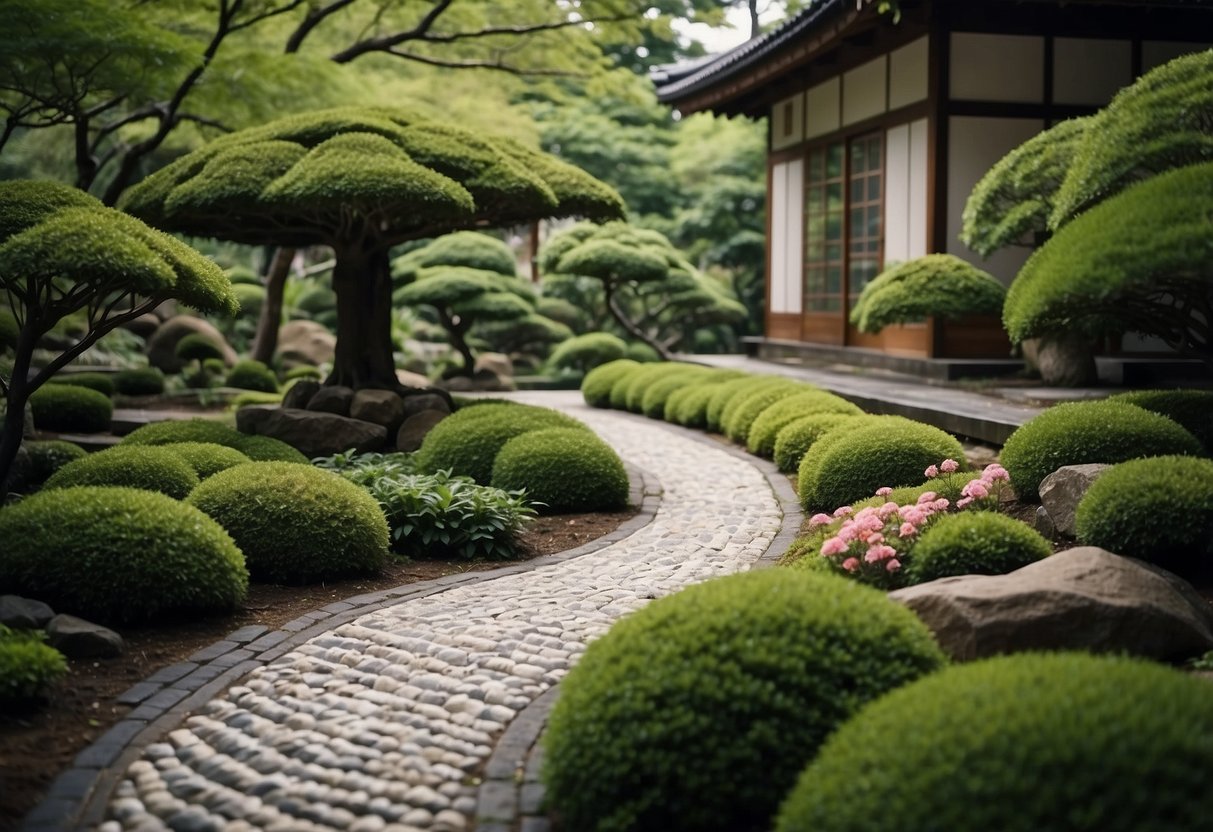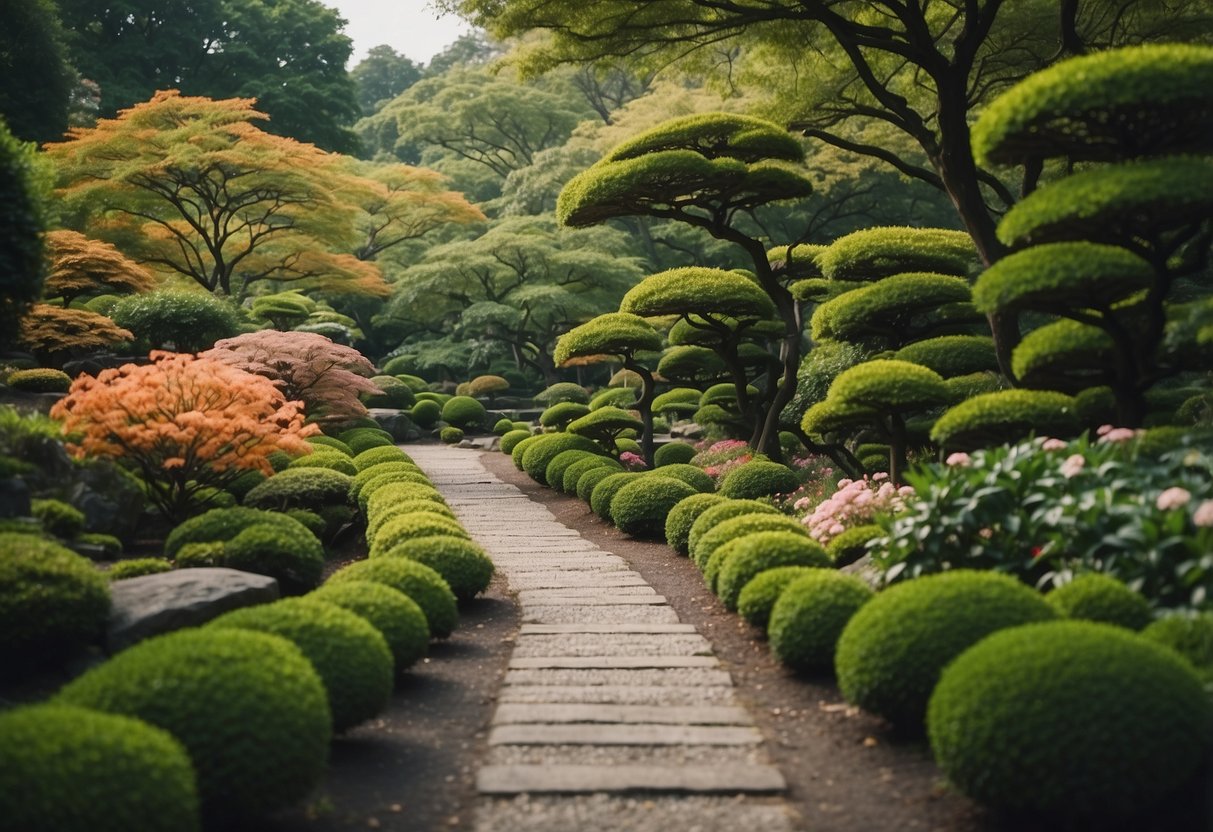Japanese Garden Path Ideas: Create a Serene Zen Oasis
Creating a Japanese garden path can transform your outdoor space into a peaceful retreat. These paths are designed to inspire tranquility and mindfulness, guiding you through lush greenery and serene water features. They invite you to take a moment to reflect and appreciate the beauty around you.

You don’t need a lot of space to incorporate Japanese garden paths. Even small gardens can benefit from the simple yet elegant design elements of Japanese aesthetics. By adding a thoughtfully designed path, you can create a harmonious and inviting environment in your own backyard.
1) Stepping Stones

Stepping stones are a great way to add charm and function to your garden. They create a path that invites you to explore your space.
Using natural stone or reconstituted stone gives an authentic touch. A winding pathway can give your garden a tranquil and meditative feel. You can find more ideas here.
Adding stepping stones helps break the monotony of long stretches of gravel or grass. They guide you to focal points like a pond or a sculpture, making your garden journey delightful.
2) Zen Gravel Path

Creating a Zen gravel path can bring a sense of calm to your garden. This type of path typically features raked gravel that forms simple, elegant patterns.
You can enhance this space with strategically placed rocks. They add an element of natural beauty and simplicity that is key to the Zen aesthetic.
Think about adding a few stepping stones. They don’t just provide a practical way to move through the garden but also add an extra layer of visual interest.
Consider using greenery or moss around the edges of the path for a soft touch.
3) Bamboo Forest Walkway

A Bamboo Forest Walkway can transform your garden into a calming retreat. These walkways are lined with tall bamboo shoots, creating a serene and cool atmosphere.
Walking through a bamboo path, you will feel surrounded by nature. The rustling of bamboo leaves in the wind adds to the peaceful feeling.
If you’re visiting Kyoto, don’t miss the famous Arashiyama Bamboo Grove. This enchanting 500-meter path offers a beautiful example of a bamboo forest walkway. It’s a perfect model to inspire your own garden path.
4) Water Feature Stone Path

Creating a water feature stone path in your Japanese garden enhances the tranquil atmosphere. These paths guide your steps along serene ponds or flowing streams.
Stepping stones over the water create a sense of journey and reflection. The sound of water combined with the solid feel of stone invites mindfulness.
Integrate smooth, flat stones with enough spacing to maintain balance. This design allows you to fully appreciate the surrounding beauty while ensuring a peaceful walk through your garden. Adding plants like sedums or Japanese forest grass near the path can enhance the natural look.
5) Winding Rock Path

A winding rock path can add a touch of tranquility to your garden. By using natural stones, you can create a path that looks like it has always been there.
This type of path encourages exploration. Curved pathways lead to hidden spots and beautiful views.
Include seating along the path for relaxation and moments of peace. For more inspiration, check out these design ideas.
6) Moss-Covered Path

A moss-covered path can add a soft, natural feel to your Japanese garden. Moss thrives in shady areas and retains water well, so it’s perfect for creating a lush, green pathway.
Imagine walking on a path lined with moss, its vibrant green contrasting with stepping stones. This creates a peaceful ambiance that makes you feel more connected to nature.
Consider using moss to highlight garden features like stone paths or water elements. This can make the greenery pop and enhance the tranquil atmosphere in your garden.
For more ideas, explore the vibrant options available at Japanese Garden Moss.
7) Tiled Footpath

A tiled footpath can be a stunning addition to your Japanese garden. It offers a clean and polished look that blends well with the natural elements of the garden.
You can choose tiles that mimic natural stones or go for traditional Japanese patterns. This choice will give your garden a unique and elegant touch.
Tiles are also easy to maintain. They are durable and can withstand various weather conditions, making them practical and beautiful. Consider adding them to create a seamless and inviting path in your garden.
8) Lush Greenery Path

Imagine walking on a path surrounded by endless green plants. You feel at peace.
Evergreen plants are perfect for creating a year-round lush look. They keep their leaves even in the winter, offering constant beauty.
Smooth pebble pathways add a nice contrast to the greenery. Together, they make for a calming and inviting garden path.
Learn more about abundant greenery from Trendey’s tips.
9) Cherry Blossom Lane

Imagine walking along a path where cherry blossoms float around you. It’s like stepping into a dream.
In Japan, you can see these magical views in places like Mount Yoshino and Shikinomichi.
Planting cherry trees in your garden can bring this beauty closer to home.
10) Lantern-Lit Walkway

Add a magical touch to your garden with a lantern-lit walkway. Stone lanterns not only add beauty but also light the path.
Choose lanterns like Yukimi (snow-viewing) or Taimaishi (pedestal lantern) to enhance the space. Place them alongside your path for a serene, well-lit experience.
Create a peaceful ambiance that promotes relaxation and mindfulness.
Designing A Japanese Garden Path

Creating a Japanese garden path involves careful selection of materials and mindful incorporation of natural elements. Each step on the path should feel tranquil and harmonious, guiding you through the garden and enhancing your connection with nature.
Choosing The Right Materials
When designing a Japanese garden path, choosing the right materials is essential. Stone is often preferred for its durability and natural appearance. You might consider using smooth, flat stones for a calming walk or rougher, textured stones to add a rustic feel.
Gravel is another popular choice. It offers good drainage and a pleasing crunch underfoot. Pea gravel can be spread between larger stones to create an appealing contrast. For a softer touch, use stepping stones placed in a bed of moss. This not only looks beautiful but also adds a lush, green element to your path.
Wood can also be an excellent option. Weathered wood planks or bamboo create a traditional feel. Ensure they are treated to withstand the elements to avoid rot and decay.
Balancing Natural Elements
Integrating natural elements helps to enhance the serene vibe of your garden. Use plants like moss and small shrubs to line the path, creating a soft and inviting border. Bamboo fences or arches can guide your journey and add vertical interest.
Water features, such as small ponds or streams, bring sound and movement to your path. You could place stepping stones across a shallow pond to create a sense of adventure.
Think about the layout of the path. Curved paths with gentle turns encourage you to slow down and enjoy the journey. Avoid straight lines as they can feel too rigid and formal. Instead, allow the path to flow naturally through the garden, creating moments of discovery with each step.
Placing a bench or a small pavilion along the path offers a place to rest and reflect, enhancing the peacefulness of your garden.
Incorporating Water Features

Adding water features to your Japanese garden can enhance its tranquility and beauty. Focus on selecting the right water element and placing it thoughtfully to create a harmonious atmosphere.
Selecting The Best Water Feature
When choosing a water feature, consider the size and scale of your garden. For smaller spaces, a simple stone basin or a trickling fountain can create a soothing ambiance without overwhelming the area. In larger gardens, you might opt for more elaborate elements like ponds, streams, or waterfalls.
Ensure the water feature complements the garden’s overall design. A tea garden pond with stepping stones can add elegance, while a minimalistic Zen pond can offer a peaceful focal point. Always choose materials that blend naturally with the surrounding landscape, like stone or bamboo.
Consider the sound of the water. The gentle trickle from a small fountain can be calming, while a larger waterfall might be more dynamic and energizing. Make sure the sound aligns with the peaceful atmosphere you aim to create.
Placement Tips
Placement is vital for maximizing the impact of your water feature. Position it where it can be easily seen and heard, but avoid placing it directly in the center to maintain a natural, flowing layout. Near a seating area is ideal, where you can enjoy the sight and sound of the water at close hand.
If you add a reflective pond, place it where it can capture the reflection of surrounding trees, rocks, and the sky. This will create a sense of depth and tranquility.
Ensure the water flow directs away from walkways to prevent slippery surfaces. Use natural elements like rocks and plants to frame the water feature, enhancing its natural appeal and helping it blend seamlessly into the garden’s design.







